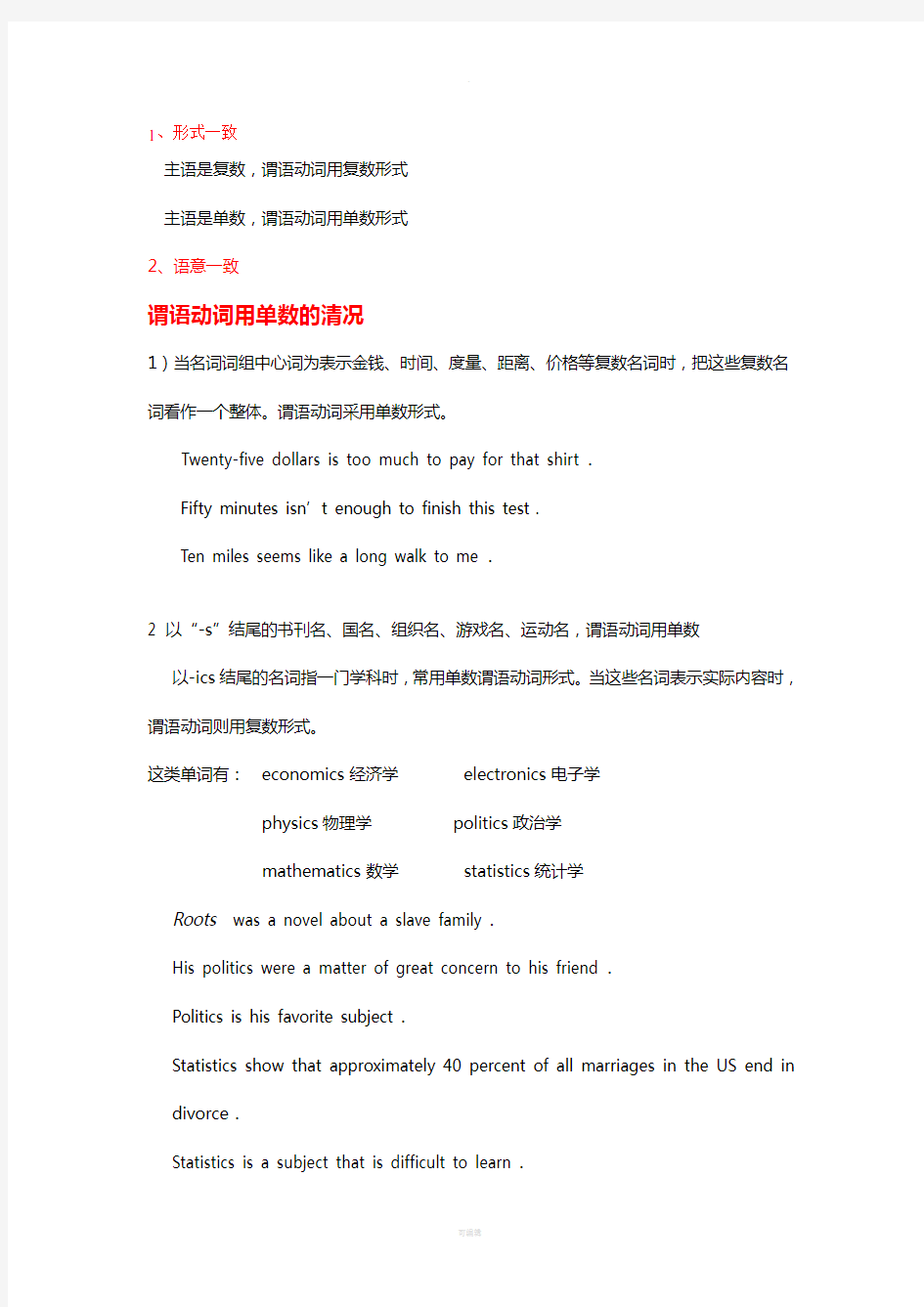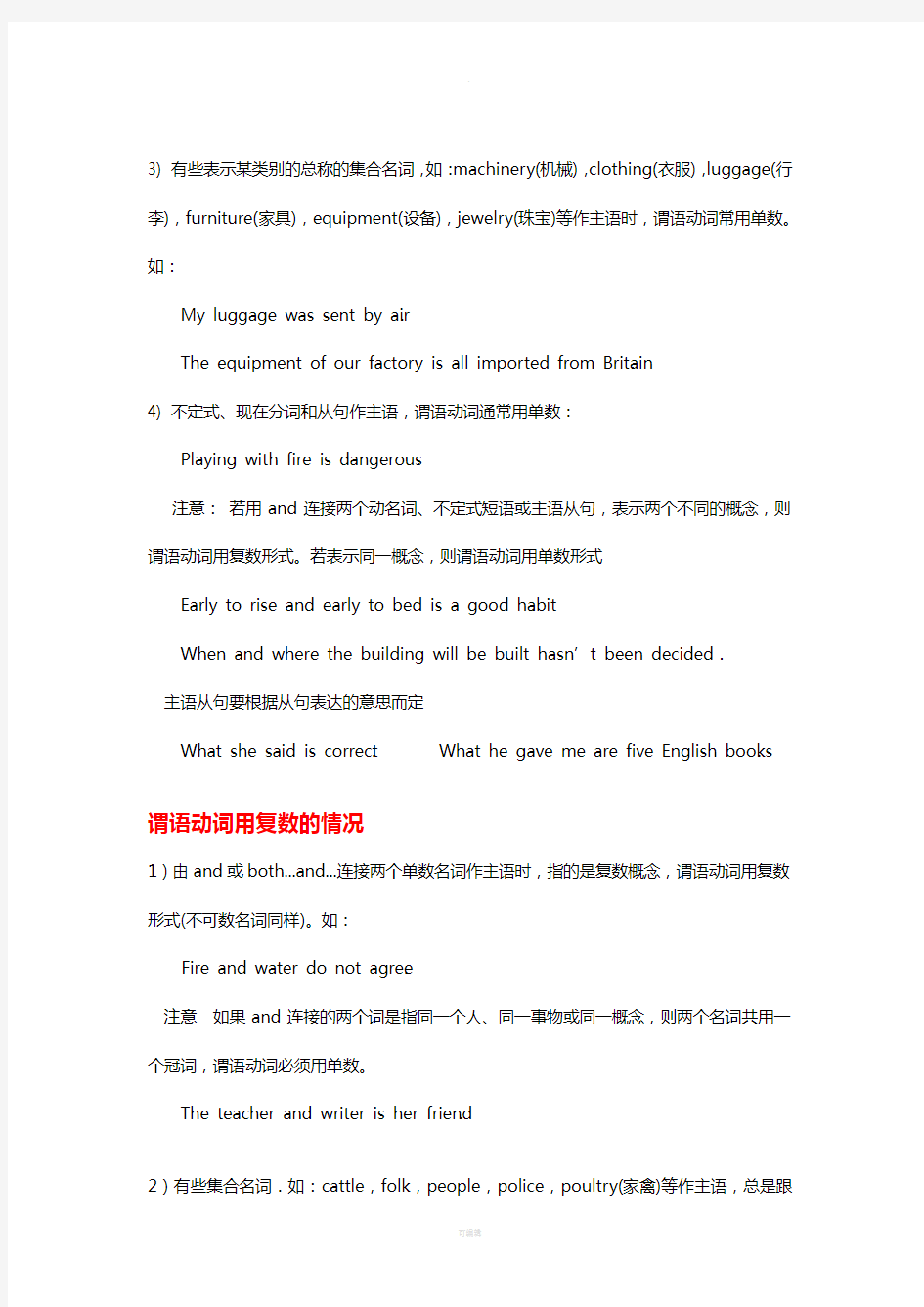

1、形式一致
主语是复数,谓语动词用复数形式
主语是单数,谓语动词用单数形式
2、语意一致
谓语动词用单数的清况
1)当名词词组中心词为表示金钱、时间、度量、距离、价格等复数名词时,把这些复数名词看作一个整体。谓语动词采用单数形式。
Twenty-five dollars is too much to pay for that shirt.
Fifty minutes isn’t enough to finish this test.
Ten miles seems like a long walk to me.
2 以“-s”结尾的书刊名、国名、组织名、游戏名、运动名,谓语动词用单数
以-ics结尾的名词指一门学科时,常用单数谓语动词形式。当这些名词表示实际内容时,谓语动词则用复数形式。
这类单词有:economics经济学electronics电子学
physics物理学politics政治学
mathematics数学statistics统计学
Roots was a novel about a slave family.
His politics were a matter of great concern to his friend.
Politics is his favorite subject.
Statistics show that approximately 40 percent of all marriages in the US end in divorce.
Statistics is a subject that is difficult to learn.
3) 有些表示某类别的总称的集合名词,如:machinery(机械),clothing(衣服),luggage(行李),furniture(家具),equipment(设备),jewelry(珠宝)等作主语时,谓语动词常用单数。如:
My luggage was sent by air.
The equipment of our factory is all imported from Britain.
4) 不定式、现在分词和从句作主语,谓语动词通常用单数:
Playing with fire is dangerous.
注意:若用and连接两个动名词、不定式短语或主语从句,表示两个不同的概念,则谓语动词用复数形式。若表示同一概念,则谓语动词用单数形式
Early to rise and early to bed is a good habit.
When and where the building will be built hasn’t been decided.
主语从句要根据从句表达的意思而定
What she said is correct.What he gave me are five English books.
谓语动词用复数的情况
1)由and或both...and...连接两个单数名词作主语时,指的是复数概念,谓语动词用复数形式(不可数名词同样)。如:
Fire and water do not agree.
注意如果and连接的两个词是指同一个人、同一事物或同一概念,则两个名词共用一个冠词,谓语动词必须用单数。
The teacher and writer is her friend.
2)有些集合名词.如:cattle,folk,people,police,poultry(家禽)等作主语,总是跟
复数动词形式。
The people hope to live a happy life.
The police have caught the criminal.
Cattle feed on grass.
3) 表示成双成套的名词,如:trousers,shoes,glasses,compasses等作主语时,谓语动词用复数。
His black trousers are too long.他的黑裤子太长。
Your glasses are on your nose.
4)表示群岛、瀑布、山脉等以“-s”结尾的专有名词作主语时,谓语动词往往用复数。
The Philippines are in the Pacific Ocean.
Rocky Mountains stand in the west of North America.
5)名词clothes,works(作“著作”讲),goods,contents,the Olympic Games的谓语动词律律用复数。如:
Clothes keep people warm.
His works have been translated into several foreign languages.
注意:若表示“一套衣服”,可用a suit of clothes。clothes不可与不定冠词a或数词连用。
若表示“一部作品”用a work,“两部作品”用two works。
谓语动词单复数由名词前面的词或词组决定的
1)由“some of,plenty of,a lot of,lots of,most of,the rest of,all of,half of,
part of,the remainder of或分数、百分数+of+名词”等短语作主语时,谓语动词常与of后的名词保持数的一致。
The rest of the lecture is dull.
Half of the apple is rotten.这个苹果的一半腐烂变质了。
Half of the apples are rotten.这些苹果有一半腐烂变质了。
About one third of the books are worth reading.大约三分之一的书值得一读。
Over 30%of the students were absent from the meeting.
2)由“a kind of,this kind of,many kinds of”和“名词+of this kind”等,以及由与kind意义相似的type,sort,form,part,piece,section等构成的类似短语作主语时,谓语动词与of前的名词保持数的一致。如:
A kind of birds has been discovered by them.
Parts of the book are very instructive.
This kind of apples is expensive.
Apples of this kind are expensive.
3)“more+复数名词+than one”结构谓语常用复数。
More members than one have protested against the plan.
4)不定代词“each,one,no one,some(any,no,every)+body(one或thing)”在句中作主语或作限定词时,谓语动词一律用单数形式
Each boy gets a prize.
Someone wants to buy the house.
Each of the books costs five Yuan.
注意:each,all,both用作同位语时,谓语动词仍应与主语保持一致
We each have an English-Chinese dictionary.
由and连接的两个或三个单数主语前如果有every,each,no,many a修饰时,谓语动词要用单数形式。
Each teacher and (each) student was given a book.
Every hour and (every) minute is important
Many a teacher and many a student enjoys the book very much.
many a.../ more than one+名词作主语时, 谓语动词仍采取单数形式
Many a man thinks life is meaningless without purpose.
one and a half+复数名词”作主语时,其谓语要用单数形式
One and a half bananas is left on the table.
3、就近原则
or,either...or...,neither...nor...,not only...but(also)...等连接的并列成分作主语时,根据就近一致的原则处理。离谓语动词近的主语部分是单数,就用单数;离谓语动词近的主语是复数,谓语动词就用复数。如:
Either the teacher or the students are to blame.
Not only the students but also their teacher doesn’t know about it.
Neither you nor I know how to do it.
4、主谓一致的特殊情况
1)population表示“人口”,一个国家或地区的居民数目,它作主语时谓语动词要用单
数形式。
当它前面有分数或百分数时,population是指一个国家或地区的全体居民,谓语动词用复数形式。
The population of Canada is about 29 million.
About eighty percent of the population of this country are peasants.
2)集合名词作主语,如果表示整体概念,谓语动词用单数形式;如表示成员则用复数。常见的这部分名词有:army,audience,class,club,committee,company,crowd,family,group,government,organization,party,team等。
Our football team is playing well.
Our football team are having baths and are then coming back here for supper. 3)a number of/a variety of/varieties of+可数名词复数; “the majority of+复数名词”作主语时,谓语动词用复数形式
the number of(表数目)和the variety of(表种类)等+可数名词作主语时,谓语动词用单数。
A number of new houses have been built there.
There are a variety of goods on sale in the shop.
The number of the people who know the secret is very limited.
The variety of goods on sale in the shop is surprising.
4) “a large amount of+不可数名词”作主语,谓语用单数
“large a mounts of+不可数名词”作主语,谓语用复数
“a large quantity of+不可数名词”作主语,谓语用单数
“a large quantity of+复数名词”作主语,谓语常用复数
“large quantities of+不可数名词/复数名词”作主语,谓语用复数
“a good/great deal of+不可数名词”作主语,谓语用单数
A large amount of clean water is wasted every day.
Vast amounts of money are being invested in the local market.
Large quantities of beer are consumed in the city every year.
A large quantity of money was spent on the bridge.
“a total of+复数名词”作主语与复数动词连用,意思是“总共有……”
“the total of+复数名词”作主语与单数动词连用,意思是“……的总数”。
4) 单复数同形的名词作主语,要根据上下文的意义以及修饰这些词的词来确定其谓语形式。常见的这部分名词有aircraft,crossroads,deer,fish,headquarters。means,series,sheep,species,works等。如:
The crossroads is/are dangerous.
Every means has been tried.
All possible means have been tried.
A steel works has just been built there.
5)当主语后面跟有with,together with,along with,accompanied by,like,in addition to,as well as,as much as,more than,rather than,no less than,except,but,besides,including等连接的词组时,其谓语动词的单复数不受这些词语的影响。如:The rock singer,along with his bodyguard,was rushed away from the theater.
Mr. Robbins,accompanied by his wife and children,is arriving tonight.
No one but your parents was there then.
Tom,together with Mary and Alice,is going to swim this afternoon.
6)the + adj./ v-ed 表示某类人作主语时,谓语动词用复数形式
the + adj. 表示某类事物或表示某一类抽象概念作主语时,谓语动词用单数形式。
The poor live a hard life.
The beautiful lives forever.
7) there be结构中的主谓一致关系,谓语动词通常和最邻近的那个主语一致。
There are four chairs and a table in the room.
8) “a/an+单数名词+or two”作主语时,谓语动词用单数。如:
“one or two+复数名词”作主语时,谓语动词用复数。如:
A student or two has failed the exam.一两个学生考试不及格。
One or two students were planting trees yesterday afternoon.昨天下午有一两个学生在植树。
9)在主语和谓语倒装的句子中,动词的数应和它后面的主语的数一致。
On the wall are some famous paintings.
Between the two windows hangs a picture.
10)在“It+ be+被强调部分+that/who...”结构中,be用单数形式is或was,如被强调部分是主语,that/who后的谓语与被强调部分的人称、数保持一致。
It is I who am a student.
It is they who have worked there for five years.